最新欧盟玩具安全指令2009-48-EC
- 格式:doc
- 大小:270.00 KB
- 文档页数:7
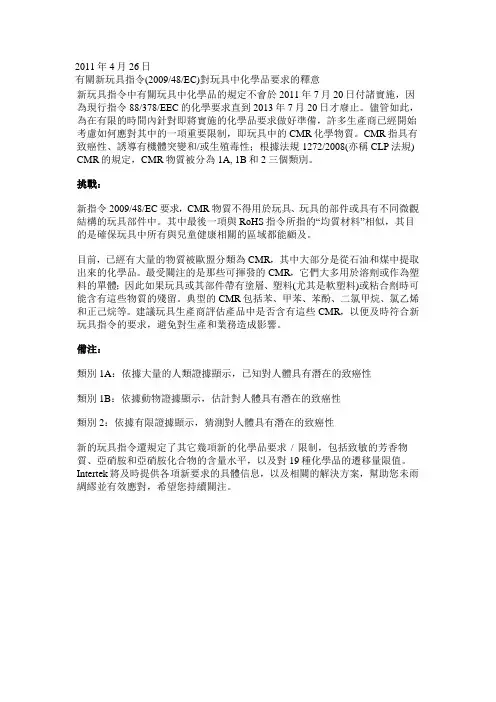
2011年4月26日有關新玩具指令(2009/48/EC)對玩具中化學品要求的釋意新玩具指令中有關玩具中化學品的規定不會於2011年7月20日付諸實施,因為現行指令88/378/EEC的化學要求直到2013年7月20日才廢止。
儘管如此,為在有限的時間內針對即將實施的化學品要求做好準備,許多生產商已經開始考慮如何應對其中的一項重要限制,即玩具中的CMR化學物質。
CMR指具有致癌性、誘導有機體突變和/或生殖毒性;根據法規1272/2008(亦稱CLP法規) CMR的規定,CMR物質被分為1A, 1B和2三個類別。
挑戰:新指令2009/48/EC要求,CMR物質不得用於玩具、玩具的部件或具有不同微觀結構的玩具部件中。
其中最後一項與RoHS指令所指的“均質材料”相似,其目的是確保玩具中所有與兒童健康相關的區域都能顧及。
目前,已經有大量的物質被歐盟分類為CMR,其中大部分是從石油和煤中提取出來的化學品。
最受關注的是那些可揮發的CMR,它們大多用於溶劑或作為塑料的單體;因此如果玩具或其部件帶有塗層、塑料(尤其是軟塑料)或粘合劑時可能含有這些物質的殘留。
典型的CMR包括苯、甲苯、苯酚、二氯甲烷、氯乙烯和正己烷等。
建議玩具生產商評估產品中是否含有這些CMR,以便及時符合新玩具指令的要求,避免對生產和業務造成影響。
備注:類別1A:依據大量的人類證據顯示,已知對人體具有潛在的致癌性類別1B:依據動物證據顯示,估計對人體具有潛在的致癌性類別2:依據有限證據顯示,猜測對人體具有潛在的致癌性新的玩具指令還規定了其它幾項新的化學品要求/ 限制,包括致敏的芳香物質、亞硝胺和亞硝胺化合物的含量水平,以及對19種化學品的遷移量限值。
Intertek將及時提供各項新要求的具體信息,以及相關的解決方案,幫助您未雨綢繆並有效應對,希望您持續關注。

欧盟修订玩具安全指令调低玩具表面刮出物六价铬限值方晔【期刊名称】《中国质量技术监督》【年(卷),期】2018(000)009【总页数】1页(P80)【作者】方晔【作者单位】【正文语种】中文近日,欧洲委员会在欧盟《官方公报》刊登第2018/725号指令,修订第2009/48/EC号指令(玩具安全框架指令)。
新指令对玩具表面刮出物,例如玩具上的涂料、软硬聚合物、木、纺织品等,实施更严格的六价铬含量限制。
根据玩具安全框架指令,六价铬被视为一种别具毒性的物质,因此其限值应定在欧盟相关科学委员会认为安全水平的一半。
目前玩具表面刮出物的六价铬限值为每公斤0.2毫克。
不过,欧盟的健康与环境风险科学委员会审视了最新的科学证据后,提出关于玩具六价铬含量的意见,建议采取更低的实际安全剂量,即人体体重每公斤每日0.0002毫克,基于此来决定玩具所含六价铬的限值。
因此,健康与环境风险科学委员会建议,修订玩具表面刮出物所含六价铬的限值至每公斤0.0094毫克。
然而,现有的测试方法无法在如此低的浓度下可靠地测量六价铬,因此该委员会决定把相关的六价铬限值修订为每公斤0.053毫克,这是目前测试方法能够可靠测量的最低浓度。
虽然限值修订至每公斤0.053毫克,欧洲标准化委员会也正审视测试方法,希望能在较低浓度下可靠地检测出六价铬。
据悉,欧委会预期修改的测试方法很快会面世,新方法能够可靠地测量低至每公斤0.0025毫克六价铬的浓度。
当新测试方法面世后,六价铬的限值将会进一步下降。
值得注意的是,玩具安全框架指令不仅适用于玩具,而且也适用于14岁或以下儿童在游戏时使用的产品。
欧盟成员国将于2019年11月17日前通过及公布必要的法例,以遵行以上的修订内容,并于2019年11月18日起实施有关法例。
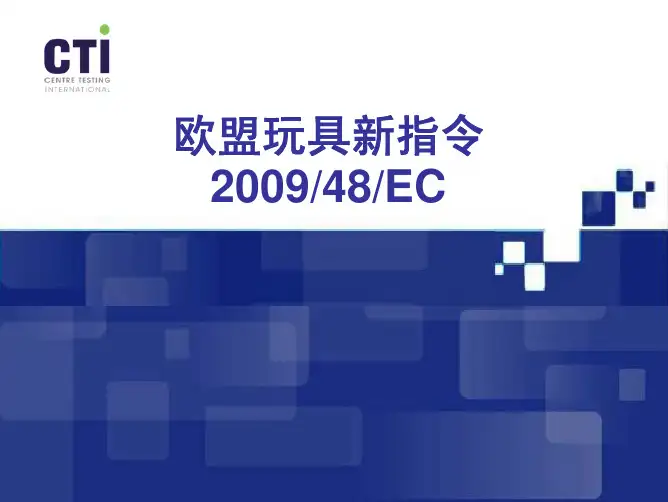
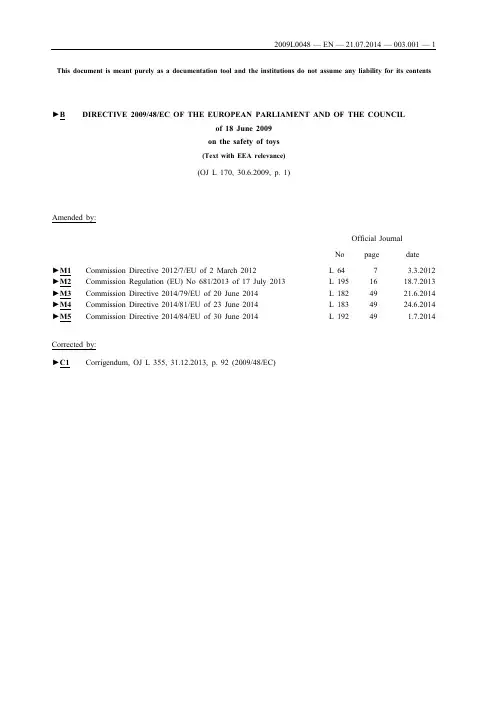
This document is meant purely as a documentation tool and the institutions do not assume any liability for its contents ►B DIRECTIVE 2009/48/EC OF THE EUROPEAN PARLIAMENT AND OF THE COUNCILof 18 June 2009on the safety of toys(Text with EEA relevance) (OJ L 170, 30.6.2009, p. 1)Amended by:Official Journal No page date ►M1 Commission Directive 2012/7/EU of 2 March 2012 L 64 7 3.3.2012 ►M2 Commission Regulation (EU) No 681/2013 of 17 July 2013 L195 16 18.7.2013 ►M3 Commission Directive 2014/79/EU of 20 June 2014 L 182 49 21.6.2014 ►M4 Commission Directive 2014/81/EU of 23 June 2014 L 183 49 24.6.2014 ►M5 Commission Directive 2014/84/EU of 30 June 2014 L 192 49 1.7.2014Corrected by: ►C1 Corrigendum, OJ L 355, 31.12.2013, p. 92 (2009/48/EC)DIRECTIVE 2009/48/EC OF THE EUROPEAN PARLIAMENTAND OF THE COUNCILof 18 June 2009on the safety of toys(Text with EEA relevance)THE EUROPEAN PARLIAMENT AND THE COUNCIL OF THE EUROPEAN UNION,Having regard to the Treaty establishing the European Community, and in particular Article 95 thereof,Having regard to the proposal from the Commission,Having regard to the opinion of the European Economic and SocialCommittee ( 1), Acting in accordance with the procedure laid down in Article 251 ofthe Treaty ( 2), Whereas:(1) CouncilDirective 88/378/EEC of 3 May 1988 on the approxi mation of the laws of the Member States concerning the safety oftoys ( 3) was adopted in the context of establishing the internal market in order to harmonise the safety levels of toys throughout the Member States and to remove obstacles to trade in toys between Member States.(2) Directive88/378/EEC is based on the New Approach principles, as set out in the Council Resolution of 7 May 1985 on a newapproach to technical harmonisation and standards ( 4). Thus, it sets out only the essential safety requirements with regard to toys, including the particular safety requirements regarding physical and mechanical properties, flammability, chemical prop erties, electrical properties, hygiene and radioactivity. Technical details are adopted by the European Committee for Standardisation (CEN) and the European Committee for Electro technical Standardisation (Cenelec) in accordance with Directive 98/34/EC of the European Parliament and of the Council of 22 June 1998 laying down a procedure for the provision of information in the field of technical standards and regulationsand of rules on Information Society services ( 5). Conformity with harmonised standards so set, the reference number of which is published in the Official Journal of the European Union , provides a presumption of conformity with the requirements of Directive 88/378/EEC. Experience has shown that these basic principles have worked well in the toys sector and should be maintained. ( 1 ) OJ C 77, 31.3.2009, p. 8. ( 2 ) Opinion of the European Parliament of 18 December 2008 (not yet published in the Official Journal) and Council Decision of 11 May 2009.( 3 ) OJ L 187, 16.7.1988, p. 1.( 4 ) OJ C 136, 4.6.1985, p. 1. ( 5 ) OJ L 204, 21.7.1998, p. 37.(3) Technologicaldevelopments in the toys market have, however, raised new issues with respect to the safety of toys and have given rise to increased consumer concerns. In order to take account of those developments and to provide clarification in relation to the framework within which toys may be marketed, certain aspects of Directive 88/378/EEC should be revised and enhanced and, in the interests of clarity, that Directive should be replaced by this Directive.(4) Toysare also subject to Directive 2001/95/EC of the European Parliament and of the Council of 3 December 2001 on generalproduct safety ( 1), which applies in a complementary manner to specific sectoral legislation.(5) Regulation(EC) No 765/2008 of the European Parliament and of the Council of 9 July 2008 setting out the requirements for accreditation and market surveillance relating to the marketingof products ( 2) lays down horizontal provisions on the accredi tation of conformity assessment bodies, on the CE marking and on the Community market surveillance framework for, and controls of, products entering the Community market which also apply to the toys sector.(6) DecisionNo 768/2008/EC of the European Parliament and of the Council of 9 July 2008 on a common framework for themarketing of products ( 3 ) provides common principles andreference provisions for the purposes of legislation based on the New Approach principles. In order to ensure consistency with other sectoral product legislation, it is appropriate to align certain provisions of this Directive to that Decision, in so far as sectoral specificities do not require a different solution. Therefore, certain definitions, the general obligations of economic operators, the presumption of conformity, formal objections against harmonised standards, rules for the CE marking, requirements for conformity assessment bodies and notification procedures and the provisions concerning procedures dealing with products presenting a risk should be aligned to that Decision.(7) Inorder to facilitate the application of this Directive by manu facturers and national authorities, the scope of this Directive should be clarified by completing the list of products which are not within its scope, in particular as regards certain new products, such as videogames and peripherals.(8) Itis appropriate to provide for certain new definitions specific to the toys sector in order to facilitate the understanding and uniform application of this Directive. ( 1 ) OJ L 11, 15.1.2002, p. 4. ( 2 ) OJ L 218, 13.8.2008, p. 30.( 3 ) OJ L 218, 13.8.2008, p. 82.(9) Toysthat are placed on the Community market should comply with the relevant Community legislation, and economic operators should be responsible for the compliance of toys, in relation to their respective roles in the supply chain, so as to ensure a high level of protection of public interests, such as health and safety, and the protection of consumers and of the environment, and to guarantee fair competition on the Community market.(10) All economic operators are expected to act responsibly and in fullaccordance with the legal requirements applicable when placing or making toys available on the market.(11) All economic operators intervening in the supply and distributionchain should take appropriate measures to ensure that under normal and reasonably foreseeable conditions of use, the toys they place on market do not jeopardise the safety and health of children and that they make available on the market only toys which comply with the relevant Community legislation. This Directive provides a clear and proportionate distribution of obligations which correspond to the role of each operator in the supply and distribution process.(12) As certain tasks can be executed only by the manufacturer, it isnecessary to distinguish clearly between the manufacturer and operators further down the distribution chain. It is also necessary to distinguish clearly between the importer and the distributor, as the importer introduces toys from third countries to the Community market. The importer has thus to make sure that those toys comply with the applicable Community require ments.(13) The manufacturer, having detailed knowledge of the design andproduction process, is best placed to carry out the complete conformity assessment procedure for toys. Conformity assessment should therefore remain the obligation of the manufacturer alone.(14) It is necessary to ensure that toys from third countries enteringthe Community market comply with all applicable Community requirements, and in particular that appropriate assessment procedures have been carried out by manufacturers with regard to those toys. Provision should therefore be made for importers to make sure that the toys they place on the market comply with the applicable requirements and that they do not place on the market toys which do not comply with such requirements or which present a risk. For the same reason, provision should also be made for importers to make sure that conformity assessment procedures have been carried out and that product marking and documentation drawn up by manufacturers are available forinspection by the supervisory authorities.(15)Where the distributor makes a toy available on the market afterthe toy has been placed on the market by the manufacturer or theimporter, it should act with due care to ensure that its handling ofthe toy does not adversely affect the compliance of the toy. Bothimporters and distributors are expected to act with due care inrelation to the requirements applicable when placing or makingtoys available on the market.(16)When placing a toy on the market, importers should indicate onthe toy their name and the address at which they can becontacted. Exceptions should be provided for in cases wherethe size or nature of the toy does not allow for such an indication.This includes cases where importers would have to open thepackaging to put their name and address on the product.(17) Any economic operator that either places a toy on the marketunder its own name or trademark or modifies a toy in such a waythat compliance with applicable requirements may be affectedshould be considered to be the manufacturer and should assume the obligations of the manufacturer.(18) Distributors and importers, being close to the market place,should be involved in market surveillance tasks carried out bycompetent national authorities, and should be prepared to participate actively, providing those authorities with all necessary information relating to the toy concerned.(19) Ensuring traceability of a toy throughout the whole supply chainhelps to make market surveillance simpler and more efficient. Anefficient traceability system facilitates market surveillance authorities' task of tracing economic operators who made non-compliant toys available on the market.(20) Certain essential safety requirements which were laid down inDirective 88/378/EEC should be updated to take account oftechnical progress since the adoption of that Directive. Inparticular, in the field of electrical properties, technical progresshas made it possible to allow the limit of 24 volts set in Directive88/378/EEC to be exceeded, while guaranteeing the safe use ofthe toy concerned.(21) It is also necessary to adopt new essential safety requirements. Inorder to ensure a high level of protection of children against riskscaused by chemical substances in toys, the use of dangeroussubstances, in particular substances that are classified as carcinogenic, mutagenic or toxic for reproduction (CMR), and allergenicsubstances and certain metals, should be subject to carefulattention. It is therefore in particular necessary to completeand update the provisions on chemical substances in toys tospecify that toys should comply with general chemicalslegislation, in particular Regulation (EC) No 1907/2006 of theEuropean Parliament and of the Council of 18 December 2006concerning the Registration, Evaluation, Authorisation and Restriction of Chemicals (REACH) and establishing a EuropeanChemicals Agency (1). Those provisions should, however, also beadapted to the particular needs of children, who are a vulnerablegroup of consumers. Therefore, new restrictions on CMR substances, in accordance with applicable Community legislationon the classification, labelling and packaging of substances andmixtures, and on fragrances in toys should be provided for onaccount of the special risks that these substances may entail forhuman health. Nickel in stainless steel has proven to be safe, andconsequently it is appropriate that it can be used in toys.(22) The specific limit values laid down in Directive 88/378/EEC forcertain substances should also be updated to take account of thedevelopment of scientific knowledge. Limit values for arsenic,cadmium, chromium VI, lead, mercury and organic tin, whichare particularly toxic, and which should therefore not be intentionally used in those parts of toys that are accessible to children,should be set at levels that are half of those considered safeaccording to the criteria of the relevant Scientific Committee, inorder to ensure that only traces that are compatible with goodmanufacturing practice will be present.(23) Toys or their parts and their packaging that can reasonably beexpected to be brought into contact with food should complywith Regulation (EC) No 1935/2004 of the European Parliamentand of the Council of 27 October 2004 on materials and articlesintended to come into contact with food (2).(24)In order to ensure adequate protection in the case of toysinvolving a high degree of exposure, it should be possible toadopt implementing measures establishing specific limit valuesfor chemicals used in toys intended for use by children under36 months and in other toys intended to be put in the mouth,taking into account the requirements of Regulation (EC) No 1935/2004 and the differences between toys and materialswhich come into contact with food.(25) The general and specific chemical requirements laid down by thisDirective should aim at protecting the health of children fromcertain substances in toys, while the environmental concernspresented by toys are addressed by horizontal environmentallegislation applying to electrical and electronic toys, namelyDirective 2002/95/EC of the European Parliament and of theCouncil of 27 January 2003 on the restriction of the use ofcertain hazardous substances in electrical and electronic equipment (3) and Directive 2002/96/EC of the European Parliament(1) OJ L 396, 30.12.2006, p. 1.(2) OJ L 338, 13.11.2004, p. 4.(3) OJ L 37, 13.2.2003, p. 19.and of the Council of 27 January 2003 on waste electrical andelectronic equipment (1). In addition, environmental issues onwaste are regulated by Directive 2006/12/EC of the EuropeanParliament and of the Council of 5 April 2006 (2), those onpackaging and packaging waste by Directive 94/62/EC of theEuropean Parliament and of the Council of 20 December1994 (3) and those on batteries and accumulators and wastebatteries and accumulators by Directive 2006/66/EC of theEuropean Parliament and of the Council of 6 September 2006 (4).(26) The system established by this Directive should also encourage,and in certain cases ensure, that dangerous substances andmaterials used in toys are replaced by less dangerous substancesor technologies, where suitable economically and technicallyviable alternatives are available.(27) In order to protect children from the risk of impairment ofhearing caused by sound-emitting toys, more stringent andcomprehensive standards to limit the maximum values for bothimpulse noise and continuous noise emitted by toys should beestablished. It is therefore necessary to lay down a new essentialsafety requirement concerning the sound from such toys.(28) In line with the precautionary principle, it is appropriate to laydown specific safety requirements to cover the potential specifichazard presented by toys in food, since the association of a toyand food could be the cause of a risk of choking that is distinctfrom the risks presented by the toy alone and which is, therefore,not covered by any specific measure at Community level.(29) Since it is possible that toys which present hazards which are notcovered by a particular safety requirement laid down in thisDirective might exist or be developed, it is necessary to set ageneral requirement of safety as the legal basis for taking actionin respect of such toys. In this respect, the safety of toys shouldbe determined by reference to the intended use, while taking intoaccount the foreseeable use, and bearing in mind the behaviour ofchildren, who do not generally show the same degree of care asthe average adult user. Where a hazard cannot be sufficientlyminimised by design or safeguards, the residual risk could beaddressed by product-related information directed at the supervisors, taking into account their capacity to cope with theresidual risk. According to acknowledged methods of riskassessment, it is not appropriate for information to supervisorsor a lack of history of accidents to be used as a substitute fordesign improvements.(1) OJ L 37, 13.2.2003, p. 24.(2) OJ L 114, 27.4.2006, p. 9.(3) OJ L 365, 31.12.1994, p. 10.(4) OJ L 266, 26.9.2006, p. 1.(30)In order to further promote safe conditions of use of toys, it isnecessary to supplement the provisions on warnings which shouldaccompany the toy. In order to prevent the misuse of warnings tocircumvent the applicable safety requirements, which has occurred in particular in case of the warning stating that thetoy is not suitable for children under 36 months, it is necessaryto provide explicitly that the warnings provided for certain categories of toy may not be used if they conflict with theintended use of the toy.(31)The CE marking, indicating the conformity of a toy, is the visibleconsequence of a whole process comprising conformity assessment in a broad sense. General principles governing theCE marking are set out in Regulation (EC) No 765/2008.Rules governing the affixing of the CE marking should be laiddown in this Directive.(32)It is crucial to make clear to both manufacturers and users that byaffixing the CE marking to the toy, the manufacturer declares thatthe toy is in conformity with all applicable requirements and thatthe manufacturer takes full responsibility therefor.(33)The CE marking should be the only marking of conformity indicating that the toy is in conformity with Community harmonisation legislation. However, other markings may be used aslong as they contribute to the improvement of consumer protection and are not covered by Community harmonisationlegislation.(34)It is appropriate to lay down rules on the affixing of CE markingwhich ensure sufficient visibility of the marking in order tofacilitate market surveillance of toys.(35)In order to ensure compliance with the essential safety requirements, it is necessary to lay down appropriate conformity assessment procedures to be followed by the manufacturer. Tocomplete the legal obligations of the manufacturer which aim atensuring the safety of toys, an explicit obligation to carry out ananalysis of the various hazards that the toy may present and anassessment of the potential exposure to them, which for chemicals includes an assessment of the likelihood of the presence in the toy of prohibited or restricted substances, should be included in this Directive, and manufacturers shouldbe obliged to keep this safety assessment in the technical documentation to allow market surveillance authorities to performtheir tasks efficiently. Internal production control based on themanufacturer’s own responsibility for the conformity assessmenthas proven adequate in cases where it has followed the harmonised standards, the reference number of which has beenpublished in the Official Journal of the European Union,covering all the safety requirements for the toy. In cases wheresuch harmonised standards do not exist, the toy should besubmitted to third party verification, in this case EC-type examination. The same should apply if one or more such standards hasbeen published with a restriction in the Official Journal of theEuropean Union, or if the manufacturer has not followed suchstandards completely, or only in part. The manufacturer shouldsubmit the toy to EC-type examination in cases where itconsiders that the nature, design, construction or purpose of thetoy necessitates third party verification.(36) Since it is necessary to ensure a uniformly high level ofperformance of bodies performing conformity assessment oftoys throughout the Community, and since all such bodiesshould perform their functions to the same level and underconditions of fair competition, obligatory requirements shouldbe set for conformity assessment bodies wishing to be notifiedin order to provide conformity assessment services under thisDirective.(37)In order to ensure a consistent level of quality in the performanceof conformity assessment of toys, it is necessary not only toconsolidate the requirements that conformity assessment bodieswishing to be notified must fulfil, but also, in parallel, to setrequirements that notifying authorities and other bodies involved in the assessment, notification and monitoring ofnotified bodies must fulfil.(38) Where the available scientific evidence is insufficient to allow anaccurate risk assessment, Member States, when taking measuresunder this Directive, should apply the precautionary principle,which is a principle of Community law outlined, inter alia, inthe Communication from the Commission of 2 February 2000,while taking due consideration of the other rules and principlescontained in this Directive, such as the free movement of goodsand the presumption of conformity.(39) Regulation (EC) No 765/2008 complements and strengthens theexisting framework for the market surveillance of productscovered by Community harmonisation legislation, including toys. Member States should therefore organise and carry outmarket surveillance of toys in accordance with that Regulation.In accordance with that Regulation, its application does notprevent the market surveillance authorities from taking morespecific market surveillance measures as are available underDirective 2001/95/EC. Furthermore, specific measures concerningthe possibility for a market surveillance authority to requestinformation from a notified body and to give instructions to itshould be included in this Directive in order to strengthen thepossibilities for action by market surveillance authorities in thecase of toys covered by an EC-type examination certificate.(40) Directive 88/378/EEC already provides for a safeguard procedureallowing the Commission to examine the justification for ameasure taken by a Member States against toys it considers tobe non-compliant. In order to increase transparency and to reduceprocessing time, it is necessary to improve the existing safeguardprocedure, with the aim of making it more efficient and ofdrawing on expertise available in the Member States.(41) The existing system should be complemented by a procedureallowing interested parties to be informed of measures takenwith regard to toys presenting a risk to the health and safety ofpersons or other issues of public interest protection. It should alsoallow market surveillance authorities, in cooperation with therelevant economic operators, to act at an earlier stage in respectof such toys.(42)Where Member States and the Commission agree as to the justification for a measure taken by a Member State, no furtherinvolvement of the Commission should be required.(43) The measures necessary for the implementation of this Directiveshould be adopted in accordance with Council Decision 1999/468/EC of 28 June 1999 laying down the procedures forthe exercise of implementing powers conferred on the Commission (1).(44) In particular, the Commission should be empowered to adaptrequirements concerning chemical properties in certain well-defined cases and to grant exemptions from the prohibitionof CMR substances in certain cases, as well as to adapt thewording of the specific warnings for certain categories of toy.Since those measures are of general scope and are designed toamend non-essential elements of this Directive, inter alia, bysupplementing it with new non-essential elements, they must beadopted in accordance with the regulatory procedure withscrutiny provided for in Article 5a of Decision 1999/468/EC.(45)Council Directive 85/374/EEC of 25 July 1985 on the approximation of the laws, regulations and administrative provisions ofthe Member States concerning liability for defective products (2)applies, inter alia, to toys which are not in conformity withCommunity harmonisation legislation. Manufacturers and importers who have placed non-compliant toys on the Community market are liable for damages under that Directive.(46) Member States should provide for penalties applicable toinfringements of this Directive. Those penalties should beeffective, proportionate and dissuasive.(1) OJ L 184, 17.7.1999, p. 23.(2) OJ L 210, 7.8.1985, p. 29.(47) In order to allow toy manufacturers and other economic operatorssufficient time to adapt to the requirements laid down by thisDirective, it is necessary to provide for a transitional period oftwo years after the entry into force of this Directive during whichtoys which comply with Directive 88/378/EEC may be placed onthe market. In the case of chemical requirements, this periodshould be set at four years so as to allow the development ofthe harmonised standards which are necessary for compliancewith those requirements.(48)Since the objective of this Directive, namely to ensure a highlevel of safety of toys with a view to ensuring the health andsafety of children whilst guaranteeing the functioning of theinternal market by setting harmonised safety requirements fortoys and minimum requirements for market surveillance, cannotbe sufficiently achieved by the Member States and can therefore,by reason of its scale and effects, be better achieved atCommunity level, the Community may adopt measures, inaccordance with the principle of subsidiarity set out inArticle 5 of the Treaty. In accordance with the principle ofproportionality, as set out in that Article, this Directive doesnot go beyond what is necessary in order to achieve thatobjective,HAVE ADOPTED THIS DIRECTIVE:CHAPTER IGENERAL PROVISIONSArticle 1Subject-matterThis Directive lays down rules on the safety of toys and on their free movement in the Community.Article 2Scope1. This Directive shall apply to products designed or intended, whether or not exclusively, for use in play by children under 14 years of age (hereinafter referred to as toys).The products listed in Annex I shall not be considered as toys within the meaning of this Directive.thefollowingtoys:2. ThistoapplyshallDirectivenot(a) playground equipment intended for public use;(b) automatic playing machines, whether coin operated or not, intendedfor public use;(c) toy vehicles equipped with combustion engines;(d) toy steam engines; and(e) slings and catapults.Article 3DefinitionsFor the purposes of this Directive the following definitions shall apply: 1. ‘making available on the market’ means any supply of a toy fordistribution, consumption or use on the Community market in the course of a commercial activity, whether in return for payment or free of charge;2. ‘placing on the market’ means the first making available of a toy onthe Community market;3. ‘manufacturer’ means any natural or legal person who manufacturesa toy or has a toy designed or manufactured, and markets that toyunder his name or trademark;4. ‘authorised representative’ means any natural or legal person established within the Community who has received a written mandate from a manufacturer to act on his behalf in relation to specified tasks;5. ‘importer’ means any natural or legal person established within theCommunity who places a toy from a third country on the Community market;6. ‘distributor’ means any natural or legal person in the supply chain,other than the manufacturer or the importer, who makes a toy available on the market;7. ‘economic operators’ means the manufacturer, the authorised representative, the importer and the distributor;8. ‘harmonised standard’ means a standard adopted by one of theEuropean standardisation bodies listed in Annex I to Directive 98/34/EC on the basis of a request made by the Commission in accordance with Article 6 of that Directive;9. ‘Community harmonisation legislation’ means any Communitylegislation harmonising the conditions for the marketing of products;10. ‘accreditation’ shall have the meaning assigned to it byRegulation (EC) No 765/2008;11. ‘conformity assessment’ means the process demonstrating whetherspecified requirements relating to a toy have been fulfilled;12. ‘conformity assessment body’ means a body that performsconformity assessment activities, including calibration, testing, certification and inspection;。
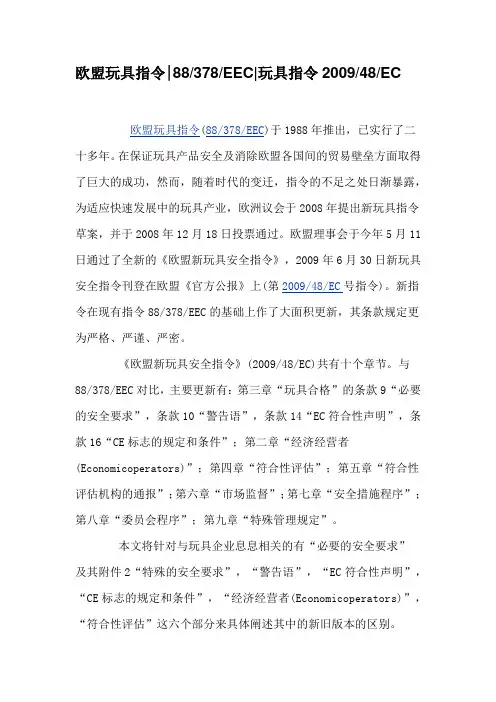
欧盟玩具指令|88/378/EEC|玩具指令2009/48/EC欧盟玩具指令(88/378/EEC)于1988年推出,已实行了二十多年。
在保证玩具产品安全及消除欧盟各国间的贸易壁垒方面取得了巨大的成功,然而,随着时代的变迁,指令的不足之处日渐暴露,为适应快速发展中的玩具产业,欧洲议会于2008年提出新玩具指令草案,并于2008年12月18日投票通过。
欧盟理事会于今年5月11日通过了全新的《欧盟新玩具安全指令》,2009年6月30日新玩具安全指令刊登在欧盟《官方公报》上(第2009/48/EC号指令)。
新指令在现有指令88/378/EEC的基础上作了大面积更新,其条款规定更为严格、严谨、严密。
《欧盟新玩具安全指令》(2009/48/EC)共有十个章节。
与88/378/EEC对比,主要更新有:第三章“玩具合格”的条款9“必要的安全要求”,条款10“警告语”,条款14“EC符合性声明”,条款16“CE标志的规定和条件”;第二章“经济经营者(Economicoperators)”;第四章“符合性评估”;第五章“符合性评估机构的通报”;第六章“市场监督”;第七章“安全措施程序”;第八章“委员会程序”;第九章“特殊管理规定”。
本文将针对与玩具企业息息相关的有“必要的安全要求”及其附件2“特殊的安全要求”,“警告语”,“EC符合性声明”,“CE标志的规定和条件”,“经济经营者(Economicoperators)”,“符合性评估”这六个部分来具体阐述其中的新旧版本的区别。
一、“必要的安全要求”下附件2“特殊的安全要求”。
1、物理和机械性能现行指令规定“玩具及部件及其包装不得存在引起儿童被勒死和窒息的危险”,新指令在此基础上新增“玩具包装不得因阻塞嘴和鼻的外部呼吸道而引起儿童窒息的危险”。
现行指令规定“针对年龄小于36个月的儿童使用的玩具及其配件与附属件应防止被此年龄段儿童吞咽和吸入的危险”,新指令将此规定范围延伸至“可放入口中的玩具及其配件与附属件”。
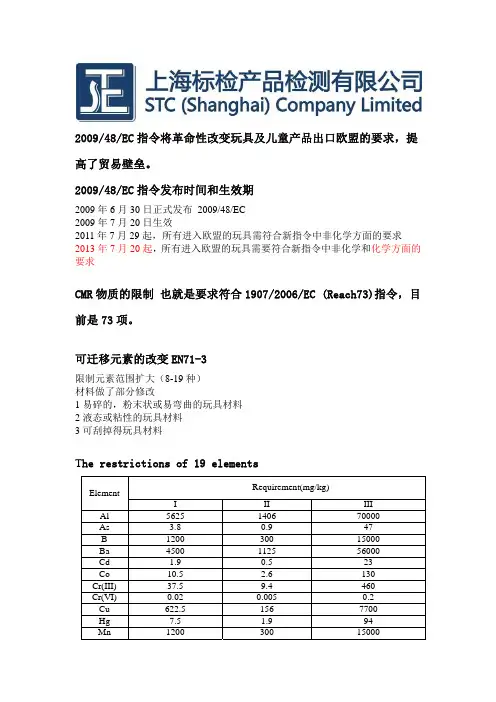
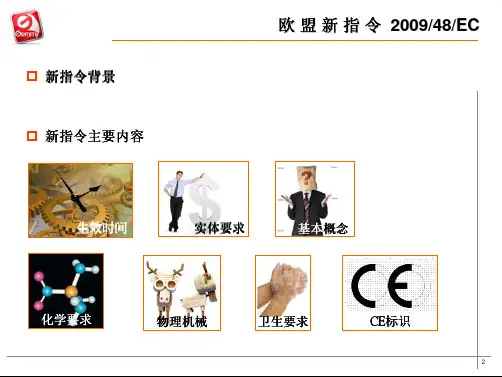
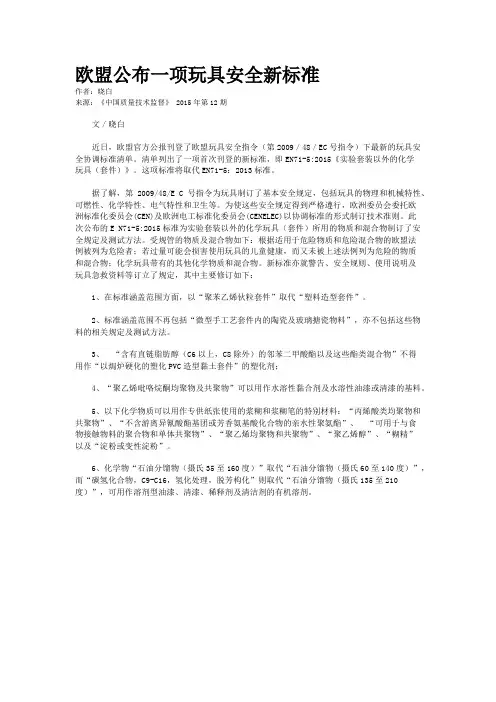
欧盟公布一项玩具安全新标准作者:晓白来源:《中国质量技术监督》 2015年第12期文/晓白近日,欧盟官方公报刊登了欧盟玩具安全指令(第2009/48/EC号指令)下最新的玩具安全协调标准清单。
清单列出了一项首次刊登的新标准,即EN71-5:2015《实验套装以外的化学玩具(套件)》。
这项标准将取代EN71-5:2013标准。
据了解,第2009/48/E C号指令为玩具制订了基本安全规定,包括玩具的物理和机械特性、可燃性、化学特性、电气特性和卫生等。
为使这些安全规定得到严格遵行,欧洲委员会委托欧洲标准化委员会(CEN)及欧洲电工标准化委员会(CENELEC)以协调标准的形式制订技术准则。
此次公布的E N71-5:2015标准为实验套装以外的化学玩具(套件)所用的物质和混合物制订了安全规定及测试方法。
受规管的物质及混合物如下:根据适用于危险物质和危险混合物的欧盟法例被列为危险者;若过量可能会损害使用玩具的儿童健康,而又未被上述法例列为危险的物质和混合物;化学玩具带有的其他化学物质和混合物。
新标准亦就警告、安全规则、使用说明及玩具急救资料等订立了规定,其中主要修订如下:1、在标准涵盖范围方面,以“聚苯乙烯伙粒套件”取代“塑料造型套件”。
2、标准涵盖范围不再包括“微型手工艺套件内的陶瓷及玻璃搪瓷物料”,亦不包括这些物料的相关规定及测试方法。
3、“含有直链脂肪醇(C6以上,C8除外)的邻苯二甲酸酯以及这些酯类混合物”不得用作“以焗炉硬化的塑化PVC造型黏土套件”的塑化剂;4、“聚乙烯吡咯烷酮均聚物及共聚物”可以用作水溶性黏合剂及水溶性油漆或清漆的基料。
5、以下化学物质可以用作专供纸张使用的浆糊和浆糊笔的特别材料:“丙烯酸类均聚物和共聚物”、“不含游离异氰酸酯基团或芳香氨基酸化合物的亲水性聚氨酯”、“可用于与食物接触物料的聚合物和单体共聚物”、“聚乙烯均聚物和共聚物”、“聚乙烯醇”、“糊精”以及“淀粉或变性淀粉”。
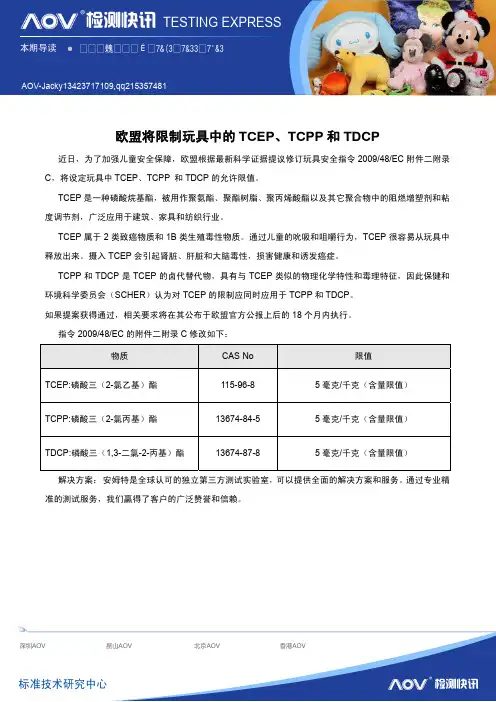
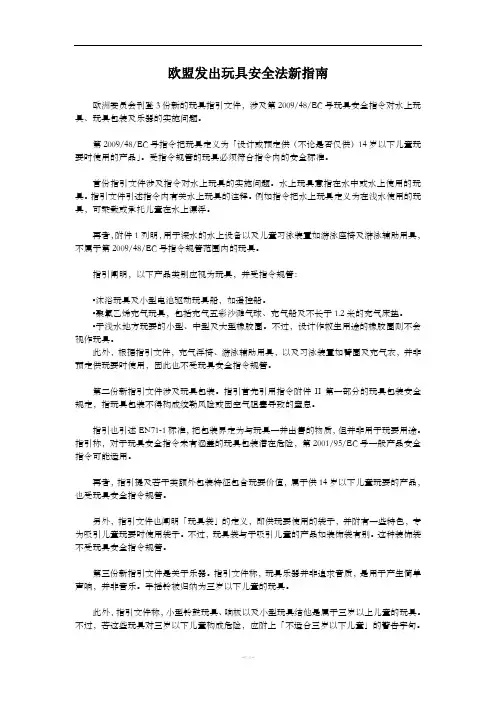
欧盟发出玩具安全法新指南欧洲委员会刊登3份新的玩具指引文件,涉及第2009/48/EC号玩具安全指令对水上玩具、玩具包装及乐器的实施问题。
第2009/48/EC号指令把玩具定义为「设计或预定供(不论是否仅供)14岁以下儿童玩耍时使用的产品」。
受指令规管的玩具必须符合指令内的安全标准。
首份指引文件涉及指令对水上玩具的实施问题。
水上玩具意指在水中或水上使用的玩具。
指引文件引述指令内有关水上玩具的注释。
例如指令把水上玩具定义为在浅水使用的玩具,可乘载或承托儿童在水上漂浮。
再者,附件1列明,用于深水的水上设备以及儿童习泳装置如游泳座椅及游泳辅助用具,不属于第2009/48/EC号指令规管范围内的玩具。
指引阐明,以下产品类别应视为玩具,并受指令规管:•沐浴玩具及小型电池驱动玩具船,如遥控船。
•聚氯乙烯充气玩具,包括充气五彩沙滩气球、充气船及不长于1.2米的充气床垫。
•于浅水地方玩耍的小型、中型及大型橡胶圈。
不过,设计作救生用途的橡胶圈则不会视作玩具。
此外,根据指引文件,充气浮椅、游泳辅助用具,以及习泳装置如臂圈及充气衣,并非预定供玩耍时使用,因此也不受玩具安全指令规管。
第二份新指引文件涉及玩具包装。
指引首先引用指令附件II第一部分的玩具包装安全规定,指玩具包装不得构成绞勒风险或因空气阻塞导致的窒息。
指引也引述EN71-1标准,把包装界定为与玩具一并出售的物质,但并非用于玩耍用途。
指引称,对于玩具安全指令未有涵盖的玩具包装潜在危险,第2001/95/EC号一般产品安全指令可能适用。
再者,指引提及若干类额外包装特征包含玩耍价值,属于供14岁以下儿童玩耍的产品,也受玩具安全指令规管。
另外,指引文件也阐明「玩具袋」的定义,即供玩耍使用的袋子,并附有一些特色,专为吸引儿童玩耍时使用袋子。
不过,玩具袋与于吸引儿童的产品如装饰袋有别。
这种装饰袋不受玩具安全指令规管。
第三份新指引文件是关于乐器。
指引文件称,玩具乐器并非追求音质,是用于产生简单声响,并非音乐。
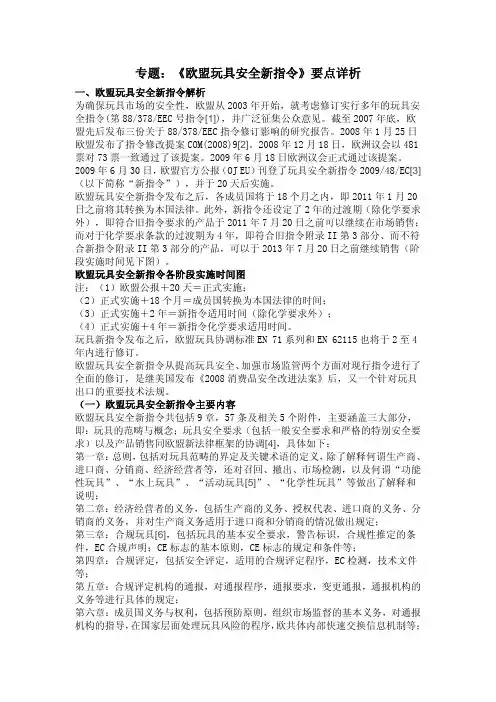
专题:《欧盟玩具安全新指令》要点详析一、欧盟玩具安全新指令解析为确保玩具市场的安全性,欧盟从2003年开始,就考虑修订实行多年的玩具安全指令(第88/378/EEC号指令[1]),并广泛征集公众意见。
截至2007年底,欧盟先后发布三份关于88/378/EEC指令修订影响的研究报告。
2008年1月25日欧盟发布了指令修改提案COM(2008)9[2]。
2008年12月18日,欧洲议会以481票对73票一致通过了该提案。
2009年6月18日欧洲议会正式通过该提案。
2009年6月30日,欧盟官方公报(OJ EU)刊登了玩具安全新指令2009/48/EC[3](以下简称“新指令”),并于20天后实施。
欧盟玩具安全新指令发布之后,各成员国将于18个月之内,即2011年1月20日之前将其转换为本国法律。
此外,新指令还设定了2年的过渡期(除化学要求外),即符合旧指令要求的产品于2011年7月20日之前可以继续在市场销售;而对于化学要求条款的过渡期为4年,即符合旧指令附录II第3部分、而不符合新指令附录II第3部分的产品,可以于2013年7月20日之前继续销售(阶段实施时间见下图)。
欧盟玩具安全新指令各阶段实施时间图注:(1)欧盟公报+20天=正式实施;(2)正式实施+18个月=成员国转换为本国法律的时间;(3)正式实施+2年=新指令适用时间(除化学要求外);(4)正式实施+4年=新指令化学要求适用时间。
玩具新指令发布之后,欧盟玩具协调标准EN 71系列和EN 62115也将于2至4年内进行修订。
欧盟玩具安全新指令从提高玩具安全、加强市场监管两个方面对现行指令进行了全面的修订,是继美国发布《2008消费品安全改进法案》后,又一个针对玩具出口的重要技术法规。
(一)欧盟玩具安全新指令主要内容欧盟玩具安全新指令共包括9章,57条及相关5个附件,主要涵盖三大部分,即:玩具的范畴与概念;玩具安全要求(包括一般安全要求和严格的特别安全要求)以及产品销售同欧盟新法律框架的协调[4],具体如下:第一章:总则,包括对玩具范畴的界定及关键术语的定义,除了解释何谓生产商、进口商、分销商、经济经营者等,还对召回、撤出、市场检测,以及何谓“功能性玩具”、“水上玩具”、“活动玩具[5]”、“化学性玩具”等做出了解释和说明;第二章:经济经营者的义务,包括生产商的义务、授权代表、进口商的义务、分销商的义务,并对生产商义务适用于进口商和分销商的情况做出规定;第三章:合规玩具[6],包括玩具的基本安全要求,警告标识,合规性推定的条件,EC合规声明;CE标志的基本原则,CE标志的规定和条件等;第四章:合规评定,包括安全评定,适用的合规评定程序,EC检测,技术文件等;第五章:合规评定机构的通报,对通报程序,通报要求,变更通报,通报机构的义务等进行具体的规定;第六章:成员国义务与权利,包括预防原则,组织市场监督的基本义务,对通报机构的指导,在国家层面处理玩具风险的程序,欧共体内部快速交换信息机制等;第七章:委员会程序,包括对措施的修订和执行及其程序;第八章:特别管理条款,包括报告,透明度及保密性,措施的动机,处罚等;第九章:最终及过渡条款,包括对同第85/374/EEC和2001/95/EC号指令的适用关系,以及过渡期的规定,新指令的实施时间以及对88/378/EEC的废止等。
IntertekCentre Court, Meridian Business Park, Leicester LE19 1WD UKAn Expert’s View of the Implications ofthe New EU Toy Directive(2009/48/EC)Implications of the New EU Toy Directive (2009/48/EC)With increasing consumer concerns on toys safety, a new EU Toy Directive, 2009/48/EC, has been published in order to cope with evolving safety issues and improve enforcement activities. Published in the Official Journal in June 2009, it will be effective from July 2011 onwards, while the current Directive 88/378/EEC will be repealed (apart from chemical aspects).This document will provide an overview of the changes in the regulations.The current EU Toy Directive, 88/378/EEC, was mandated more than 20 years ago. During the past two decades, toys have changed significantly and the current Directive can no longer provide comprehensive coverage on the safety of toys. The new chemical requirements will be effective from July 2013 onwards.The key changes are highlighted briefly below:∙Drawing up of the EC Declaration of Conformity∙Carrying out safety assessments under Article 18∙New migration limits for 19 restricted elements∙Toys shall comply with the EU REACH regulation∙Ban on substances classified as CMR (Carcinogenic, Mutagenic or Toxic for Reproduction) ∙55 allergenic fragrances may not be used in toys. Only technically unavoidable traces are allowed up to 100 parts per million (ppm).∙Cosmetic toys shall comply with Directive 76/768/EEC∙11 allergenic fragrances in Annex II of 76/768/EEC shall be listed on toys at concentration exceeding 0.01% by weight∙ A toy intended for use by children under 36 months must be designed and manufactured in such a way that it can be cleaned∙Toys contained in food must have their own packaging∙Toys that are firmly attached to food are prohibited∙New provisions on sound-emitting toys∙Nitrosamines and Nitrosatable substances banned in toys for children under 36 months or mouth-contact toysOther requirements include new requirements and warnings on labels and production control on manufacturing process.Cleaning of Toys Intended for Children Under 36 MonthsThere will be new legal requirement for all toys intended for children under 36 months for products first placed on the European market from 20 July 2011.A toy intended for use by children under 36 months must be designed and manufactured in such a way that it can be cleaned. A textile toy shall be washable (which means by soak washing), except if it contains a mechanism that may be damaged if soak washed. The toy shall fulfil the safety requirements also after having been cleaned in ac cordance with this point and the manufacturer‟s instructions.Guidance published by the European Commission has defined textile toys as “…toys entirely made of textile with exception for materials inside the toy and minor features or decorationssewed/adhered to the outside (e.g. eyes and nose). They can have a mechanical non textile component (mechanism) on the inside. Textile toys would therefore include soft plush toys and disguise costumes for children under 36 months. Additional examples can be found in the guidance document. Furthermore the guidance makes it clear that “Soak washing means immersing the toy in water or other liquid; this handling does not necessarily imply machine washing, it can be hand wash.”The manufacturer shall also carry out an analysis of all hazards mentioned in Article 18 after cleaning, among them hygiene hazards as well as an assessment of the potential exposure to all such hazards. For example, small parts hazards that appear after cleaning or soak washing need to be assessed.As part of the Safety Assessment that a manufacturer is obligated to carry out under Article 18, consideration should be given as to what safety aspects may be compromised after washing. Relevant testing can then be carried out after washing to assess this if appropriate.Toys Associated with FoodFor products first placed on the European market from 20 July 2011, there will be new legal requirements for toys associated with food.The directive states:1) Toys contained within food or co-mingled with food must have their own packaging. Thispackaging, as it is supplied, must be of such dimensions as to prevent it being swallowedand/or inhaled. Such toys shall bear the following:“Toy inside. Adult Supervision recommended”.2) Toy packaging, which is spherical, egg-shaped or ellipsoidal, and any detachable parts ofthis or of cylindrical toy packaging with rounded ends, must be of such dimensions as toprevent it from causing airway obstruction by being wedged in the mouth or pharynx orlodged over the entrance to the lower airways.3) Toys firmly attached to a food products at the moment of consumption, in such a way thatthe food product needs to be consumed in order to get direct access to the toy, shall beprohibited. Parts of toys otherwise directly attached to a food product shall fulfil therequirements set out in (Annex II 1, 4) (c) and (d).Guidance published by the European Commission indicates that:∙The requirements apply regardless of age.∙Toys within food must be contained within their own packaging which separates the toy from the food. That packaging must not fit within the small parts cylinder specified inEN 71-1.∙Certain shapes of packaging e.g. spherical, egg-shaped and detachable parts of it must not pass through Template E (small balls template) specified in EN 71-1. This also applies tothe detachable parts of cylindrical toy packaging with rounded ends. (These requirementsregarding certain shapes of packaging apply to all packaging and not only to packaging oftoys associated with food.)∙Detachable parts are those which are produced following testing to EN 71-1 clause 5.1.∙Products where the food has to be consumed in order to get direct access to the whole toy are prohibited. In cases where the toy is attached to the food but is accessible withoutconsuming the food, the toy and its parts must not fit within the small parts cylinder or pass through Template E.Other implications for product design and labellingAs a result of new requirements of 2009/48/EC, the European toy standard EN 71-1 has been revised.Among other changes there are implications for toys intended to be placed in the mouth which mean that there must be no small parts produced from any part of the toy, regardless of whether the toy is “mouth actuated” and whether the part is intended to be placed in the mouth.Warnings which determine the decision to purchase must be visible at the point of sale, whether that is in store, on-line or through a catalogue. They must be preceded by the word “Warning” and even if the graphical symbol is used it must be accompanied by the word “Warning”.The name and address of the manufacturer should be on the toy unless there is good reason for it not to be. In the case of the identification (e.g. batch number, SKU, model number) this must be on the toy unless it is not technically possible or it would be illegible.Technical DocumentationThe manufacturer is obligated to produce and retain technical documentation for 10 years. While similar to the existing requirements under the current directive, such technical documentation must now include a Declaration of Conformity in the form specified in the directive and a Safety Assessment. The latter is basically a risk assessment which should include all hazards and an assessment of whether they are covered by the harmonised toy standards, or whether a Type Examination is required in cases where the hazards are not addressed by standards.Chemicals in ToysThe new legal requirements covering chemicals in toys will not apply on July 20, 2011, as the existing chemical requirements of Directive 88/378/EEC will not be repealed until 20 July 2013. Nevertheless, to better prepare for the several upcoming chemical challenges within a limited time frame, many manufacturers have started looking into one of the major new restrictions with regards to CMR chemicals in toys. CMRs refer to chemicals that are carcinogenic (C), mutagenic (M) and/or toxic to reproduction (R). In principle, CMRs are classified as category 1A, 1B or 2 under Regulation 1272/2008 (referred to as the CLP Regulation).The new Directive 2009/48/EC requires that CMRs shall not be used in toys, components of toys or micro-structurally distinct parts of toys. The latter term is similar to the term …homogeneous material‟ as applied to the ROHS directive and is intended to ensure that all areas of the toys that could be of relevance for the safety of the child are considered.There are a huge number of CMRs classified by the EU at the moment, and the majority of them are chemicals derived from petroleum and coal. CMRs of utmost concern will be those volatile CMRs which are frequently used in solvents or as monomers of plastics, and hence may be found in residual amounts if the toy or its components contain paint coatings, plastics (especially soft plastics), adhesive, etc. Typical examples of these CMRs include benzene, toluene, phenol, dichloromethane, vinyl chloride and n-hexane. Toy manufacturers are highly advised to evaluate the possible presence of these CMRs in their products in order to address the possible impact of the new toy directive.There are several other new chemical requirements/restrictions under the new toy directive which include allergenic fragrances, nitrosamines and nitrosatable levels, and migration limits for 19 chemicals. Please stay tuned while Intertek continues to furnish detailed information on each new requirement as well as our solution to help you get prepared well ahead.The SolutionIntertek, through our extensive global network, has a variety of services available to help you overcome the challenges related to complying with the new directive. Besides keeping you updated on any new developments, Intertek provides legal, regulatory and strategic consulting, testing, implementation programmes for compliance to the new directive, chemical testing and analysis and advice and guidance on compiling a technical file and a Declaration of Conformity. We can even provide system certification to meet your production control requirements.iComplyAs a solution to compliance with a number of regulations, Intertek developed iComply™, a user-friendly, web-based artificial intelligence application facilitating collaborative supply chain assembly of technical files. iComply™ is a simple solution built on sophisticated technology that takes a sequence of product-specific information entered by the importer or manufacturer, PRODUCES a production test plan, GENERATES necessary compliance declaration documents and STORES all documentation in a complete technical documentation file, all of which is available for easy access 24 hours a day, 7 days a week.iComply™ is a one-stop-shop solution that enables you to demonstrate due diligence and guides you through the compliance process for the EU Toy Directive and proposed CPSIA Testing and Certification Rule. Additional modules are currently being developed for the Canada Consumer Product Safety Act and Proposition 65. iComply™ provides a complete solution to your record-keeping and compliance needs.For more information on specific testing and certification information, please contact Intertek by emaliing @, or visit our website at .About the AuthorPhilip Bullock, BSc (Hons), CChem, MRSC,Technical Manager – Toys & HardlinesPhilip graduated in analytical chemistry in 1982. He has over 30 years experience in quality control and technical support, formerly for a major UK retailer and for Intertek for the past 11 years. As a member of the Toy Industries of Europe Technical Committee, he has been involved in discussions on the new Toy Directive for many years. He is a member of various BSI committees, including CW/15 (Safety of Toys), and the BTHA Toy Interpretations Group. He attends both UK and European co-ordination meetings of Toy Notified Bodies and is also a Technical Assessor for toy and consumer products on behalf of UKAS.This publication is copyright Intertek and may not be reproduced or transmitted in any form in whole or in partwithout the prior written permission of Intertek. While due care has been taken during the preparation of this document, Intertek cannot be held responsible for the accuracy of the information herein or for anyconsequence arising from it. Clients are encouraged to seek Intertek’s current advice o n their specific needsbefore acting upon any of the content.IntertekCentre Court, Meridian Business Park, Leicester LE19 1WD UK专家解析新欧盟玩具指令(2009/48/EC)新欧盟玩具指令(2009/48/EC)要求释意由于人们对玩具的安全性日益关注,欧盟颁布了新的玩具指令2009/48/EC,旨在应对不断变化的玩具安全问题,并提升执法力度和有效性。
欧盟新玩具安全指令2009/48/EC2012-02-16 12:37----------------------------------------------------------------------------------------------法规名称:关于玩具安全的欧洲议会和理事会指令法规简称:新玩具安全指令法规编号:2009/48/EC发布时间:2009-06-18生效时间:2009-07-20法规简介现阶段,玩具制造商,进口商以及经销商,可以采用旧玩具安全指令88/378/EEC,也可以采用新玩具安全指令2009/48/EC。
从2011年7月20日起,新玩具安全指令2009/48/EC将在欧盟各成员国强制执行,并且是唯一适用玩具产品的指令。
玩具安全指令2009/48/EC对旧指令的修改•禁止使用致癌物质,诱变剂或对生殖系统有毒性(DMR物质)的化学物质;•限制重金属的含量(铅,镉和汞);•为避免过敏反应,对可能引起过敏的物质和某些香料的使用,做出了规定;•对发声玩具,制定了更加严格和全面的标准;•执行风险评估程序;•需符合必要的安全要求;•附带产品图片和编号的EC一致性声明。
旧版指令(88/378/EEC)Vs新版指令(2009/48/EC)内容88/378/EEC2009/48/EC适用范围与定义变化(1) 玩具定义——新指令将玩具的定义修订为“设计为或者预定为供14 岁以下儿童玩耍中使用的产品,无论是否是专用的产品。
”从而扩大了玩具指令的适用范围(有可能被儿童用来玩耍的产品也被认为是玩具);此外,列出了19条不属于玩具的产品,包括节日或庆典的装饰品、仿真模型、藏品等。
如溜冰鞋(20 kg 以下儿童使用)、家用的儿童运动器材等都列入玩具的范畴。
(2) 增加了制造商、进口商的定义——新指令对玩具“制造商”、“进口商”和“分销商”进行了明确的定义,并新增了对进口商和分销商的义务要求。
CN-414 / Aug 2010最新欧盟玩具指令2009/48/EC内容解释现行的欧盟玩具指令88/378/EEC实施至今有20多年的时间,在过去的20年中,玩具产品不断推陈出新,现行的指令已不能全面涵盖玩具的安全问题。
由于消费者对玩具安全的日益关注,欧盟于2009年6月发布了新的玩具指令2009/48/EC,旨在解决新的安全问题,并加强执法。
新的玩具指令将于2011年7月开始生效,届时现行的指令88/378/EEC将作废。
新的化学要求将于2013年7月开始生效。
挑战:∙新的19项受限制元素迁移限值;∙玩具应符合欧盟REACH法规;∙对CMR类物质(致癌、诱导有机体突变或对生殖系统有毒害的物质)的禁令;∙55种致敏性芳香物质不能用于玩具,仅允许技术上无法避免的含量在100 ppm (百万分之)以下的痕量存在;∙化妆品玩具应符合指令76/768/EEC的要求;∙如果玩具含有76/768/EEC附件II中列举的11种致敏性芳香物质,当含量超过重量的0.01%,应在玩具上注明;∙食品中的玩具必须有独立包装;∙玩具不得牢固地粘附于食品;∙有关发声玩具的新规定;∙有关警告和标签的新规定;∙36个月以下儿童使用的玩具或与嘴部接触的玩具中不得含有亚硝胺(Nitrosamines)和亚硝基胺(nitrosatable)物质;∙供36个月以下儿童使用的玩具必须被设计和制作为可以清洁的(详见下文)。
其它要求还有EC合格声明,根据第18条进行安全评估,以及制造流程的生产控制等。
供36个月以下儿童使用的玩具清洁要求在新玩具指令中,有一项针对供36个月以下儿童使用的所有玩具的新要求,即从2011年7月20日起,所有供36个月以下儿童使用的玩具必须被设计和制作为可以清洁的。
依照这一规定,纺织品制作的玩具必须是可以洗涤的,除非玩具含有浸泡后可能被损坏的机械装置。
同时,玩具在依照法规和生产商的指南清洗后,仍须满足安全要求。
除纺织品玩具必须是可以清洗的之外(除非当中含有被浸泡清洗后可能损坏的机械装置),其它玩具的清洁方式并没有限定。
英国2009 年玩具安全法规
英国在2009年执行的玩具安全法规是欧盟玩具安全指令(法规编号为2009/48/EC)。
需要注意的是,英国退出欧盟后,该法规在英国市场的执行要求有所变更。
英国退出欧盟后,在英国市场执行的玩具监管要求将由欧盟玩具安全指令变更为修订后的英国玩具(安全)法规(名称变更为2011 )。
该法规条例中欧盟特定的参考资料和内容被删除,并替换为英国的等效资料。
如需了解更多关于英国玩具安全法规的信息,建议咨询相关专家或查阅相关法律法规。
欧盟最新玩具安全指令2009/48/EC
2009年6月30日,欧盟在官方刊物上正式发布了最新的玩具安全指令2009/48/EC,这个新指令将逐步取代旧版的88/378/EEC指令,成为管控欧盟玩具安全的主要指令。
比较旧指令,新指令2009/48/EC在以下五个方面作出了更新:
新指令针对工厂的新要求:
1.工厂应该对产品可能存在的化学、物理、机械、电、阻燃性能、卫生以及放射方面的危险
进行分析。
2.通过CE符合性声明,工厂应该承担玩具符合各项要求的责任。
(CE符合性声明应该声明
符合所有相关安全要求)
3.技术文件:
●设计及加工的详细描述,包括组件及所用材料清单,及所使用的化学物质的安全数据
表;
●执行过的安全评估;
●符合性评估程序的描述;
●CE符合性声明的复印件;
●生产及储存的地址;
●CE证书以及工厂递交给通报机构(NB)文件的复印件(如果工厂进行过CE认证)
●测试报告以及有关工厂确保产品符合相关协调标准的方法的描述;
新指令针对玩具物理及机械性能的新要求:
1.食品中的玩具或者跟食品混合在一起的玩具必须要独立包装。
2.在享用食物时跟食物紧紧相连的玩具是被禁止的。
(即为了要得到玩具而需首先吃掉上面的
食物,这种设计是被禁止的。
)
新指令针对玩具化学性能的新要求:
1.致癌物质、诱导有机体突变的物质或者对生殖有害的物质不允许被用于玩具、玩具部件和
玩具微观机构中。
2.亚硝胺以及亚硝胺化合物被禁止用于三岁以下儿童的玩具中以及倾向被放到嘴里的其它玩
具。
3.玩具不应含有如右表中的过敏性香料:
List A
4.在玩具或部件中以下过敏性香料浓度超过100ppm,其名字应标注在玩具、标签、包装或附
带的宣传单上。
List B
List C
新指令针对玩具警告语的新要求:
1.玩具上不能有与其功能、尺寸及特性相冲突的特殊警告语。
2.适用消费者的最小至最大年龄段,以及其它适用的警告语应该显示在包装上或当消费者购
买之前可以清晰看到的地方。
3.针对在食品里面或者跟食品混合的玩具应该标注如下警告语:
“Toy inside. Adult supervision recommended!”
4.在化装包、嗅觉及味觉游戏中存在的香料包装应有如下警告语:
“Contains fragrances that may cause allergies”
新指令中认为不属于玩具的产品:
1.节日及庆祝活动的装饰物;
2.收藏品,产品及包装上明显显示该产品是给14岁及以上人使用的;
3.给体重超过20公斤以上儿童的运动设备,包括溜冰鞋、直排溜冰鞋及滑板;
4.座垫最大高度大于435毫米的自行车;
5.设计给体育运动用的或者公路上、公用的道路上使用的滑板车及其它类似的交通工具;
6.用在公路上、公用的道路以及人行道上使用的电驱动交通工具;
7.用在深水中的水上设备,儿童用游泳学习装备,例如游泳椅及游泳臂圈等辅助物;
8.五百块以上的拼图;
9.气枪以及长度超过120厘米的弓,水枪除外;
10.带有不是特别设计给玩具的雷管的焰火;
11.带尖点发射物的产品及游戏,例如带金属头的飞镖;
12.功能性的教育用品,例如电压超过24伏在成人监督下用来教学目的的电炉、电熨斗以及
其它电的产品;
13.在学校里教学用的用品,以及成人老师监督下的教学工具,例如科学设备;
14.电子设备,例如个人电脑,游戏机,除非是特意为儿童设计并且本身具有玩耍的价值;
15.休闲娱乐用的交换式软件和存储设备,例如电脑游戏,CD光盘;
16.婴儿安抚奶嘴;
17.吸引儿童的灯具
18.玩具用变压器;
19.不用来玩耍的儿童服饰配件;
新指令的执行时间表:
新指令的生效日期为2009年7月20日。
考虑到各成员国以及玩具生产商和销售商的准备需要时间,欧盟设立了一定的缓冲时间(即过渡期),以辅助成员国把新指令转化为各国法律。
具体的时间为:
成员国须将新指令转化成法律的最晚日期:2011年1月20日
新指令开始执行的最晚日期:物理机械及其他部分:2011年7月20日
化学部分:2013年7月20日。